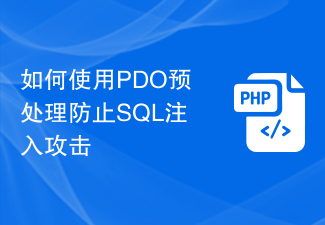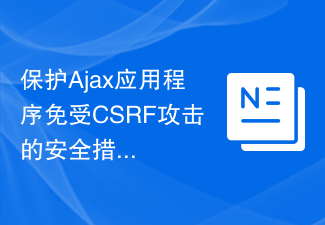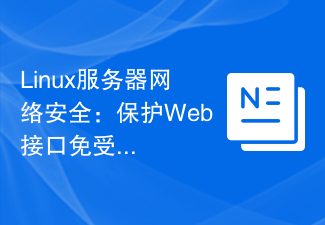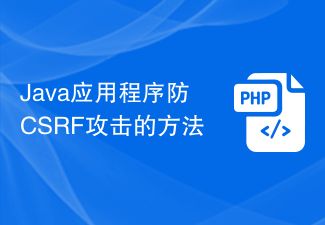 Backend Development
Backend Development PHP Tutorial
PHP Tutorial How to use PHP to defend against cross-site request forgery (CSRF) and SQL injection attacks
How to use PHP to defend against cross-site request forgery (CSRF) and SQL injection attacksHow to use PHP to defend against cross-site request forgery (CSRF) and SQL injection attacks
With the continuous development of Internet technology, network security issues have increasingly become the focus of attention. Among them, cross-site request forgery (CSRF) and SQL injection attacks are two common network attack methods. In order to protect data security, developers need to take appropriate security measures. This article will introduce how to use PHP to defend against these two attacks.
- Cross-site request forgery (CSRF) attack defense
CSRF attack is a way to obtain the user's sensitive information by using the user's logged-in identity to initiate illegal requests. Or attack means to conduct malicious operations. In order to defend against CSRF attacks, the following measures can be taken:
1.1 Verify the source
When processing a user request, you should check whether the source of the request is legitimate. You can determine whether the request comes from a legitimate site by checking the Referer field in the HTTP header. If the source of the request is not a legitimate site, the request should be denied.
1.2 Use token verification
Using token verification is a common method to defend against CSRF attacks. Each time a user visits the page, generate a unique token and include it in the form on the page. When the user submits the form, the token is compared to the token stored on the server. If the two are consistent, the request is legitimate, otherwise the request should be rejected.
- SQL injection attack defense
SQL injection attack refers to an attack method that injects malicious SQL code into the data input by the user to perform illegal operations on the database. In order to defend against SQL injection attacks, the following measures can be taken:
2.1 Use prepared statements
Preprocessed statements refer to the data entered by the user by binding parameters before executing the SQL statement. deal with. Both PHP's PDO and MySQLi extensions support prepared statements. Using prepared statements can prevent malicious injection attacks and improve the execution efficiency of SQL statements.
2.2 Input filtering and verification
Before receiving the data entered by the user, the data entered by the user should be filtered and verified. You can use PHP's built-in functions such as filter_var() to filter and validate user-entered data. Depending on your needs, you can filter out special characters or accept only certain types of input.
2.3 Properly setting database permissions
Properly setting database user permissions is an important part of defending against SQL injection attacks. When deploying applications, you should use the principle of least privilege, which means setting the minimum privileges for database users and providing corresponding privileges only when needed.
The above are some common ways to use PHP to defend against cross-site request forgery (CSRF) and SQL injection attacks. However, security protection is an ongoing process, and attackers are constantly improving their attack methods. Therefore, developers need to remain vigilant at all times and promptly update security measures to protect the security of user data.
The above is the detailed content of How to use PHP to defend against cross-site request forgery (CSRF) and SQL injection attacks. For more information, please follow other related articles on the PHP Chinese website!
 java框架安全架构设计如何防止 CSRF 攻击?Jun 06, 2024 pm 12:21 PM
java框架安全架构设计如何防止 CSRF 攻击?Jun 06, 2024 pm 12:21 PMJava框架通过以下方法来防止CSRF攻击:校验CSRFToken:服务器验证请求中的CSRFToken是否与Session中的Token匹配。SynchronizerTokenPattern(STP):使用与特定表单或链接相关的Token,服务器验证该Token是否与提交或点击表单/链接时发送的Token匹配。DoubleSubmitCookies:使用两个Cookie来验证请求来自有效用户。
 如何使用PDO预处理防止SQL注入攻击Jul 28, 2023 pm 11:18 PM
如何使用PDO预处理防止SQL注入攻击Jul 28, 2023 pm 11:18 PM如何使用PDO预处理防止SQL注入攻击引言:在进行Web开发过程中,我们经常需要与数据库进行交互。然而,不正确的数据库查询操作可能导致严重的安全风险,其中一种被广泛利用的攻击方式就是SQL注入攻击。为了防止SQL注入攻击,PDO提供了一种预处理机制,本文将介绍如何正确地使用PDO预处理。什么是SQL注入攻击:SQL注入是一种针对数据库的攻击技术,攻击者通过在
 如何防范SQL注入攻击?May 13, 2023 am 08:15 AM
如何防范SQL注入攻击?May 13, 2023 am 08:15 AM随着互联网的普及和应用场景的不断拓展,我们在日常生活中使用数据库的次数越来越多。然而,数据库安全问题也越来越受到关注。其中,SQL注入攻击是一种常见且危险的攻击方式。本文将介绍SQL注入攻击的原理、危害以及如何防范SQL注入攻击。一、SQL注入攻击的原理SQL注入攻击一般指黑客通过构造特定的恶意输入,在应用程序中执行恶意SQL语句的行为。这些行为有时候会导致
 保护Ajax应用程序免受CSRF攻击的安全措施Jan 30, 2024 am 08:38 AM
保护Ajax应用程序免受CSRF攻击的安全措施Jan 30, 2024 am 08:38 AMAjax安全性分析:如何防止CSRF攻击?引言:随着Web应用程序的发展,前端技术的广泛应用,Ajax已经成为了开发人员日常工作中不可或缺的一部分。然而,Ajax也给应用程序带来了一些安全风险,其中最常见的就是CSRF攻击(Cross-SiteRequestForgery)。本文将从CSRF攻击的原理入手,分析其对Ajax应用的安全威胁,并提供一些防御C
 PHP安全防护:控制CSRF攻击Jun 24, 2023 am 08:22 AM
PHP安全防护:控制CSRF攻击Jun 24, 2023 am 08:22 AM随着互联网的发展,网络攻击的频率越来越高。其中,CSRF(Cross-SiteRequestForgery)攻击已成为网站或应用程序的主要威胁之一。CSRF攻击指的是攻击者利用用户已登录的身份,通过伪造请求来实现非法操作。PHP是一种常用的服务器端编程语言,开发者需要注意PHP安全防护以避免CSRF攻击。以下是一些控制CSRF攻击的方法:1.使用CSRF
 PHP数据过滤:预防XSS和CSRF攻击Jul 29, 2023 pm 03:33 PM
PHP数据过滤:预防XSS和CSRF攻击Jul 29, 2023 pm 03:33 PMPHP数据过滤:预防XSS和CSRF攻击随着互联网的发展,网络安全成为人们关注的焦点之一。在网站开发中,对于用户提交的数据进行过滤和验证是非常重要的,尤其是预防XSS(跨站脚本攻击)和CSRF(跨站请求伪造攻击)攻击。本文将介绍如何使用PHP来防止这两种常见的安全漏洞,并提供一些示例代码供参考。预防XSS攻击XSS攻击是指恶意攻击者通过注入恶意脚本或代码来篡
 Linux服务器网络安全:保护Web接口免受CSRF攻击。Sep 11, 2023 pm 12:22 PM
Linux服务器网络安全:保护Web接口免受CSRF攻击。Sep 11, 2023 pm 12:22 PMLinux服务器网络安全:保护Web接口免受CSRF攻击近年来,随着互联网的普及和发展,人们对网络安全的重视程度也越来越高。作为一个基于开源原则的操作系统,Linux在网络安全领域拥有广泛的应用和认可。在Linux服务器的使用中,保护Web接口免受CSRF(Cross-SiteRequestForgery)攻击是一项至关重要的任务。CSRF攻击是一种利用
 Java应用程序防CSRF攻击的方法Jun 30, 2023 pm 11:27 PM
Java应用程序防CSRF攻击的方法Jun 30, 2023 pm 11:27 PM如何保护Java应用程序免受CSRF攻击随着网络技术的发展,网络攻击也越来越多样化和复杂化。跨站请求伪造(CSRF)是一种常见的网络攻击方式,它通过伪造用户请求,利用用户登录状态实施恶意操作,给系统和用户带来不可估量的损失。Java应用程序作为广泛使用的开发语言,在防范和应对CSRF攻击方面,有着一系列的安全措施和最佳实践。本文将介绍一些常见的方法和技术,帮


Hot AI Tools

Undresser.AI Undress
AI-powered app for creating realistic nude photos

AI Clothes Remover
Online AI tool for removing clothes from photos.

Undress AI Tool
Undress images for free

Clothoff.io
AI clothes remover

AI Hentai Generator
Generate AI Hentai for free.

Hot Article

Hot Tools

WebStorm Mac version
Useful JavaScript development tools

SublimeText3 Mac version
God-level code editing software (SublimeText3)

SublimeText3 Chinese version
Chinese version, very easy to use

Safe Exam Browser
Safe Exam Browser is a secure browser environment for taking online exams securely. This software turns any computer into a secure workstation. It controls access to any utility and prevents students from using unauthorized resources.

Dreamweaver Mac version
Visual web development tools





